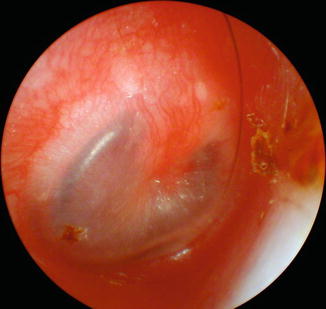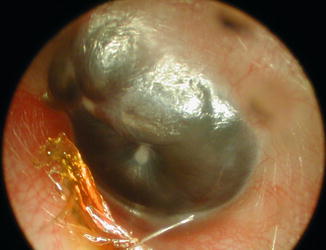Fig. 40.1
Normal tympanic membrane, right ear

Fig. 40.2
Vascularization around the manubrium mallei due to Eustachian tube dysfunction, right ear

Fig. 40.3
Barotrauma during descent of the airplane, left ear, tympanic membrane is dark blue and bulging
40.9 Sinus Barotrauma
The paranasal sinuses also contain air, with the consequence that barotrauma of these structures may occur in flying and diving. As the water pressure changes during a dive, the sinuses normally equalize automatically by free passage of gas into or out of their openings. Problems are inevitable, however, if these openings become obstructed.
The production of pathology as a result of a change of pressure is directly related to the degree of patency of the sinus ostium and to the nasal function. Factors creating edema of the nasal mucosa are commonly found as predisposing causes, for example, chronic sinus inflammation (sinusitis), nasal inflammation (rhinitis), folds of tissue (polyps), coryza and its infective sequelae, vasomotor rhinitis, seasonal allergy, the effects of mechanical obstruction secondary to nasal injury, and deflection of the nasal septum. Unlike the middle ear, which can be ventilated through the eustachian tube voluntarily, there is no voluntary control over the diameter of the sinus ostium so that equalization of pressure may be difficult (Edmonds 2012b).
During descent (the compression phase) when the ostium is obstructed, the gas in the sinus will be compressed, causing barotrauma of descent (according to Boyles’ law). The shrinking volume is replaced by swelling of the sinus lining, tissue fluid, or bleeding – partly filling the sinus. If the descent continues mucosal vessels rupture and a subepithelial hematoma may develop.
If the sinus opening becomes obstructed during ascent, the gas contained in the sinus expands, causing the symptoms. This is called sinus barotrauma of ascent. Sinus barotrauma of descent is more common than ascent, but they often coexist. The degree of pathological change is proportional to the magnitude of the pressure differential and the period of time over which the pressure imbalance is unrelieved.
40.10 Conclusions
To maintain equal pressure on both sides of the tympanic membrane (TM), gas must move freely between the nasopharynx and middle ear. Sniffing, sneezing, and nose blowing may not have any significant effect on normal eustachian tubes; however, these may be the trigger factor and the cause of middle ear pathologies. Normal functioning of the ear is closely related to, and depends on, the health status of the nose, paranasal sinuses, and the throat. Pathology of the nose, sinuses, and nasopharynx has a very important role in the cause, treatment, and sequelae of ear disease. The pathologies of the nose should be treated to have a normal physiology of the ear. In other words, if the patient has an ear pathology, the nose and sinuses should be very carefully evaluated.
Bilateral nasal obstruction plays a very important role on the function of the eustachian tube. Nasal obstruction may cause high positive pressure in the middle ear and can also affect the clearance function of the eustachian tube and force the materials back to the tympanum. Nasal pathologies may interfere with eustachian tube function during changes in environmental pressure and may cause otitic barotrauma.



